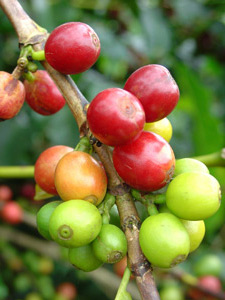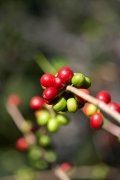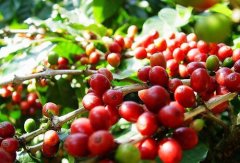Boutique coffee is classified according to sieve grade.
sieve classification
The method of sieve classification is the method of classifying coffee green beans according to their size. Raw beans are passed through a perforated iron sieve to determine the size of the beans and thus the grade. The size of the holes in the screen is 1/64 inch (less than 0.4mm), so the number of screens indicates that there are several 1/64 inches. For example, the size of No. 17 screen is 17/64 inches, which is about 6.75mm. Therefore, the larger the number of screens, the larger the particles of coffee beans. The reason for this classification is that larger beans sell better and produce more varied flavors than smaller beans. However, it is not that the beans with large particles must be of better quality than the beans with small particles. Ethiopian coffee beans are generally narrow and small, but their taste is the most unforgettable and favorite, including Yunnan's small coffee, which is highly evaluated in the international market. Kenya is one of the most representative countries classified by screen, others include Tanzania, Colombia, etc.(some countries use more than one classification method, and the examples given here are representative of countries dominated by this method). Kenya's highest AA++ requires a sieve of 18 or more, which means that the bean size exceeds 7.15mm. Kenyan beans are carefully graded to include AA++, AA+, AA, AB, etc. Colombia's classification is simpler, divided into Supremo and Excelso according to bean size. 80% of the special grade raw beans need to use more than 17 mesh screens, 80% of the upper grade raw beans need to use more than 14/16 mesh screens, and at most 11% of the 14 mesh beans are allowed in the 16 mesh beans. The screen mentioned above is for flat beans, round beans (Pea Berry) have their own set of screen size standards. The round beans are generally graded using a sieve of 8- 12.

Important Notice :
前街咖啡 FrontStreet Coffee has moved to new addredd:
FrontStreet Coffee Address: 315,Donghua East Road,GuangZhou
Tel:020 38364473
- Prev

Fine coffee is graded according to the altitude of the coffee producing area.
The classification criteria such as the altitude classification of coffee producing areas are mainly because the quality of coffee produced at high altitude is generally higher than that at low altitude, because high altitude and low temperature, slow coffee production is conducive to the accumulation of good substances. And the raw beans with high maturity have good expansibility when baking, which is beneficial to baking, and the quality is more stable. Coffee production using this grading standard at present
- Next

How are coffee beans classified according to the proportion of sieve and defective beans?
The classification of defective beans according to the proportion of sieve and defective beans is an important factor to destroy the flavor of the final coffee. Therefore, defective beans should also be removed in the last step of raw bean processing. Therefore, according to the proportion of defective beans, supplemented by the size of the screen is also used as a way of classification. Due to the rise of boutique coffee, coffee producing countries pay more and more attention to the quality of coffee, and the control of defective beans is the most important way.
Related
- What is the meaning of lactic acid fermentation with coffee bean treatment?
- How to judge the state of foam by sound?
- How does the latte pull out the unicorn pattern? Come to get for a little trick to improve the flower pull!
- Will flower pulling affect the taste of the latte?
- Do you know the history of coffee?
- The difference between honey treatment and sun washing what is raisin honey treatment?
- What kind of milk can a novice use to make coffee foam to keep the foam longer? The correct method and skills of milking tutorial sharing
- Why do washed coffee beans taste sour? Flavor characteristics of washed Coffee
- Introduction to the skill of how to practice the size and height of water injection around the circle of hand-brewed coffee
- How do beginners practice coffee flower drawing from scratch?

